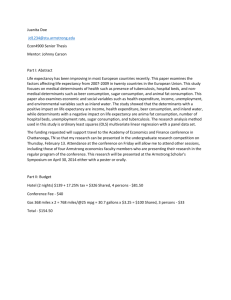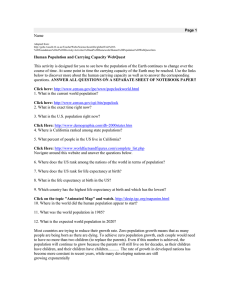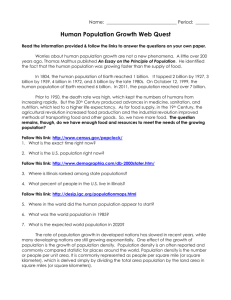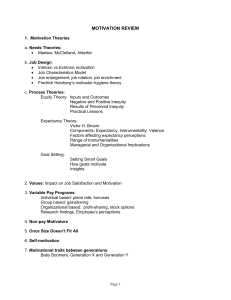Health and Health Care in Japanese Elderly Hideki Hashimoto July 29, 2011
advertisement
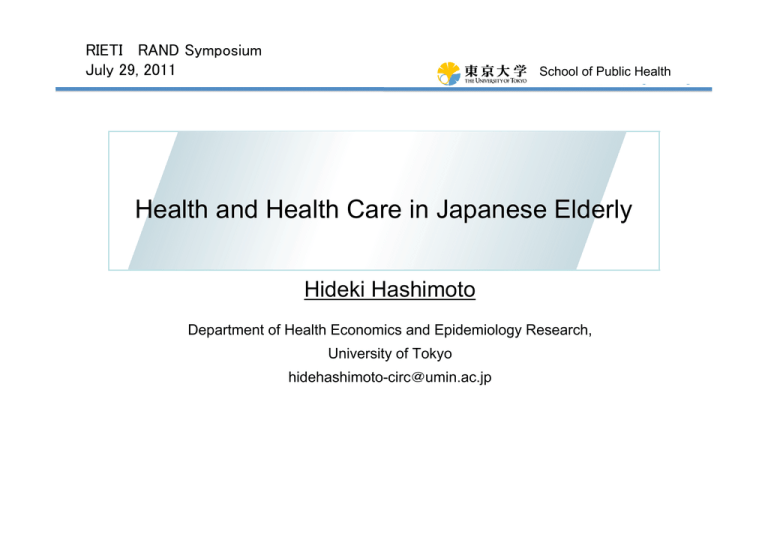
RIETI RAND Symposium July 29, 2011 School of Public Health Health and Health Care in Japanese Elderly Hideki Hashimoto Department of Health Economics and Epidemiology Research, University of Tokyo hidehashimoto-circ@umin.ac.jp Life expectancy at birth: 1900‐2008 Women 85 Life expectancy (years) 80 75 70 65 60 55 50 45 40 35 30 25 1900 Australia UK Germany France Italy Sweden Canada USA Japan (1947-2008) Japan (1900-1936) 1920 1940 1960 Year 1980 2000 Source: Ikeda et al 2011, in press 1 Life expectancy (years) Life expectancy at birth: 1900‐2008 85 Men 80 75 70 65 60 55 50 45 40 35 30 25 1900 Australia UK Germany France Italy Sweden Canada USA Japan (1947-2008) Japan (1900-1936) 1920 1940 1960 Year 1980 2000 Source: Ikeda et al 2011, in press 2 In this presentation • Demographic/ epidemiological analysis on Japanese longevity • Healthcare system – Access, quality, expenditure • Life style factor, focusing diet • Conclusion Contributions to changes in life expectancy 1950 – 1965, MEN Changes in life expectancy at birth (years) 4 Other Neonatal conditions Maternal conditions COPD and asthma Cancers and other neoplasms Ischemic heart disease Cerebrovascular disease Other infectious diseases Tuberculosis 3 2 1 0 0-4 5-14 15-59 60-74 75+ 4 Source: Ikeda et al 2011, in press Age-Standardized Mortality Rate per 100,000 Major driver since late 1960s; rapidly reduced stroke mortality Australia UK Germany France Italy Sweden Canada USA Japan 400 300 200 100 0 1950 1960 1970 1980 Year 1990 2000 2008 Source: Ikeda et al 2011, in press 5 Changesin life expectancy at birth (years) Contributions to changes in life expectancy 1965 – 1980, MEN 4 3 Other Maternal conditions Cancers and other neoplasms Cerebrovascular disease Tuberculosis Neonatal conditions COPD and asthma Ischemic heart disease Other infectious diseases 2 1 0 0-4 5-14 15-59 60-74 75+ Source: Ikeda et al 2011, in press 6 Changes in life expectancy at birth (years) Contributions to changes in life expectancy 1980 – 1995, WOMEN 4 3 Other Maternal conditions Cancers and other neoplasms Cerebrovascular disease Tuberculosis Neonatal conditions COPD and asthma Ischemic heart disease Other infectious diseases 2 1 0 0-4 5-14 15-59 60-74 75+ 7 Source: Ikeda et al 2011, in press Contributions to changes in life expectancy 1995 – 2008, WOMEN Changes in life expectancy at birth (years) 4 3 Other Maternal conditions Cancers and other neoplasms Cerebrovascular disease Tuberculosis Neonatal conditions COPD and asthma Ischemic heart disease Other infectious diseases 2 1 0 0-4 5-14 15-59 60-74 75+ Source: Ikeda et al 2011, in press 8 Number of deaths attributable to risk factors, 2007 (Deaths from non-communicable diseases and injuries) 0 Tobacco smoking High blood pressure High blood glucose Physical inactivity High dietary sodium Alcohol use Helicobacter pylori Hepatitis C virus Low fruit & vegetables Overweight/obesity Low PUFA High LDL cholesterol Hepatitis B virus Human papilloma virus HTLV-1 High dietary TFA 20 (Thousands) 40 60 80 Cardiovascular Diabetes Respiratory 100 120 Cancer Other NCD Injuries Source: Ikeda et al 2011, in press 9 of Public Health School 公開講座「防ぐ。」 Longevity of Japanese people Prolonged life expectancy of the elderly because of reduced mortality of stroke and heart diseases Especially, among those 75+ Could be attributed to Health care and public health intervention for hypertension Life style factors (e.g. change in diet) Question; Will this trend continue? What happens to current 50s and 60s (future 75+) Health care in Japan of Public Health School 公開講座「防ぐ。」 Low expenditure for Total Health Expenditure per GDP (%) Source) OECD Health Data 2011 12 of Public Health School 公開講座「防ぐ。」 High % of public expenditure for Total Health Expenditure Source) OECD Health Data 2011 13 of Public Health School 公開講座「防ぐ。」 High level of horizontal equity in access to medical care Country and year Japan (2007) Taiwan (2001) U.K. (1996) Germany (1996) Germany (1996) Type of physician visit Any visit (outpatient and inpatient) & to traditional medicine Western physicians General practitioner General practitioner Specialist Concentration index (CI) Horizontal index (HI) -0∙0360 0∙0135 -0∙0180 -0∙0076 -0∙0124 0∙0130 0∙0209 0∙0109 -0∙0082 0∙0243 Sources) The estimated number for Japan is original by the authors, based on Comprehensive Survey of People’s Living Conditions, 2007 The estimated numbers in Germany and UK were cited from van Doorslaer, et al. 2004, Tables 1 and 2 The estimated numbers for Taiwan were cited from Lu, et al. 2007, Table 3 Source: Ikegami et al 2011, in press 14 of Public Health School 公開講座「防ぐ。」 Predicted vs. Actual Out-of-pocket payment in JSTAR Outpatient service Dental service Concentration Curve(s) 0 0 .2 .2 .4 .4 C(p) C(p) .6 .6 .8 .8 1 1 Concentration Curve(s) 0 .2 .4 .6 Percentiles (p) line_45ー pred .8 oop_out_all 1 0 .2 .4 .6 Percentiles (p) line_45ー pred .8 1 oop_dental_all Tobit model adjusting for age, sex, smoking, chewing problem, insurance types, employment, BMI, grip strength, cognitive function, depression, sensory function, comorbidity (heart, lung, cancer, hypertension, diabetes, stroke, arthritis, cataract) 15 of Public Health School 公開講座「防ぐ。」 Equity in contribution to health expenditure Kakwani index for each source of contribution Direct tax Indirect tax Social health insurance premium Out–of-pocket payment Total of all sources financing healthcare Japan (2004) 0·186 -0·034 -0·043 -0·061 -0·021 Korea (2000) 0·268 0·038 -0·163 0·012 -0·024 Taiwan (2000) 0·260 0·030 -0·031 -0·096 -0·012 Germany (1989) 0·249 -0·092 -0·098 -0·096 -0·045 NA NA 0·111 -0·340 0·001 UK (1993) 0·284 -0·152 0·187 -0·223 0·051 US (1987) 0·210 -0·067 0·018 -0·387 -0·130 France (1989) * Estimation of Germany, France, UK, and US cited from Wagstaff, et al. (1999) Table 6.1 Estimation of Taiwan and Korea cited from O’Donnell, et al. (2008) Table 3.2 Source: Ikegami et al 2011, in press 16 of Public Health School 公開講座「防ぐ。」 Share of out-of-pocket payment in household income JSTAR 1st wave report, Ichimura, et al. 200917 of Public Health School 公開講座「防ぐ。」 Access to healthcare in Japan High achievement of equity in access and contribution to healthcare A sign of gap across income status Recent reform plan (increase in copayment rate for the elderly) needs precautious assessment on health impact among the elderly 18 of Public Health School 公開講座「防ぐ。」 Post-operative mortality comparable with U.S. reference) OECD Health Data 2010 reference) The Commission on Physician Supply, Ministry of Health, Labour, and Welfare, 2005 Available at http://www.mhlw.go.jp/shingi/2005/03/s0311-5a4.html Source: Hashimoto et al 2011, in press 19 of Public Health School 公開講座「防ぐ。」 Poor coverage of chronic conditions in primary care Sources) National Health and Nutrition Survey 2007 (Japan) National Health and Nutrition Examination Survey 2007-2008 (U.S,) Source: Hashimoto et al 2011, in press 20 of Public Health School 公開講座「防ぐ。」 Preventive service in Japan Not covered by National Health Insurance Segmented according to work status National health-checkup system since 2010, though the gap b/w segments remains 21 of Public Health School 公開講座「防ぐ。」 Preventive service use in JSTAR population Odds ratio of health checkup in the previous year Less chance if older, female, less educated, unemployed/retired, and disabled Considerable variation across cities 22 of Public Health School 公開講座「防ぐ。」 Baseline conditions and trajectory of healthcare expenditure (N=1146, whose claim data available) Expenditure (JPY) 出典) XXXX Adjusted for age, sex, obesity, ADL, city Multivariate regression on baseline characteristics Diabetes, hypertension, and mobility limitation related to consistently higher expenditure over time Stroke showed decrease over time, shift to long-term care? 23 of Public Health School 公開講座「防ぐ。」 Quality of healthcare and projection of expenditure Poor primary care and preventive services on conventional risk factors May lead to health gap across socioeconomic positions May also result in deceleration/deterioration of longevity (early sign in male life expectancy, already) 24 Life style special focus on diet of Public Health School 公開講座「防ぐ。」 Is Japanese diet healthy? Traditional meal was very salty Improvement in diet protein and cholesterol as well as reduction in salt intake contributed to stroke (bleeding) reduction “Westernization” Rice More of dietary pattern cereal remains as a core meal fish than meat (unsaturated fat) 26 of Public Health School 公開講座「防ぐ。」 Dietary pattern observed in JSTAR population 27 of Public Health School 公開講座「防ぐ。」 Dietary pattern observed in JSTAR population 28 of Public Health School 公開講座「防ぐ。」 Dietary pattern observed in JSTAR population 29 of Public Health School 公開講座「防ぐ。」 Factors associated with healthy diet Naha people showed better profile of fat intake (less saturated, more unsaturated) and lower protein intake Unmarried status related to poorer diet (less protein and unsaturated fat, less vege/fruits) Older and retired/homemaker had better profile Functional limitation relates to poor diet 30 of Public Health School 公開講座「防ぐ。」 Conclusion (tentative) So far so good Quality problems in primary care and preventive service is a threat both to population health and financial sustainability Life style modification (tobacco cessation and healthy diet) should be enhanced to keep healthy ageing in Japan, and close a health gap among the elderly. 31 Thank you Comments? hidehashimoto‐circ@umin.ac.jp

